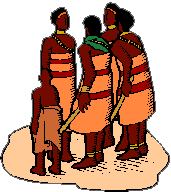|
Jambo Means Hello |
|
|
Table of Contents
|
Objectives: 1. Students will gain an appreciation
for Swahili as a language spoken in many parts of Africa. Key Words: dialect Swahili translation language Timeline: 4-6 hours Materials: KidPix Deluxe, Microsoft Word, paper, crayons, color pencils, markers, construction paper, Internet resources. Procedures: 1. Ask your students whether they have ever heard the phrase "hakuna matata?" Are they familiar with the words "rafiki" or "simba?" These words from Disney's animated Lion King, are not fictional but were borrowed from the Swahili language. Of the over eight hundred African languages spoken on the continent, Swahili is the most common. It is a language spoken by about 45 million people that reside in the eastern region of Africa. Because of the grand geographical expanse in which this language is spoken, it serves as a unifying and common language to many African people. The following African nations have residents that speak Swahili: Tanzania, Kenya, Somalia, Uganda, Rwanda, Zaire, Comorro, Oman, Congo, Madagascar, South Africa, United Arab Emirates, Malawi, Mozambique, Zambia, and the Central African Republic. Swahili is the most widely spoken African language, with 50 million speakers in East Africa and Central Africa, particularly in Tanzania (including Zanzibar) and Kenya. 2. Using a world map, point to the location of Eastern Africa to illustrate where Swahili is most spoken. 3. Inform that they will create an ABC picture book of English words with its Swahili translation. Show students a example of an alphabet book. Point out the way the illustrators have used color, page layout, and pictures to create the book. 4. Have the students divide a piece of paper into two columns. On one side have them make a list of 26 English words that represent Africa (animals of Africa, objects, places, etc.) excluding any words with the letter Q and X. They will then write the Swahili translation on the other side. They can also create a 2-column table in Microsoft Word to complete this task. Each column with a header for Swahili and one for English. 5. Student will than translate the words into Swahili and write the translation next to the English word. 6. Students will then browse the Internet to obtain a picture of the word or can draw a picture using any of the KidPix tools (Stamps, Stickers, and Animations). 7. Using all their materials, students will create a page for each word with a picture and the Swahili translation. 8. Once they have completed all their pages have the students print the pages and gather them in a book. Using construction paper, student can create a colorful cover to bind the book. 9. Have the students share their books with younger students in the school or display the books in the media center. Assessment: Completed ABC book with illustrations and translations. Extension Activities: Have the student read African folktales
such as Why Mosquitoes Buzz in
Peoples Ears, Why the Sky is Far Away: A Nigerian Folktale, or Jambo
Means Hello: Swahili Alphabet Book. Then have them write and illustrate
their own African folktale using the words in the ABC book. The Kamusi Project : Internet Swahili dictionary. Online Flashcards: downloadable flash cards of the Swahili language. Brief History: general information on the origins and history of the Swahili language. The Swahili Coast: teacher resource and lesson plans of the Swahili language. PBS: Africa for Kids: on-line Swahili folktales. Swahili Language: general list of Swahili words with English translation. Languages: general categorized list of Swahili words with English translation.
|
